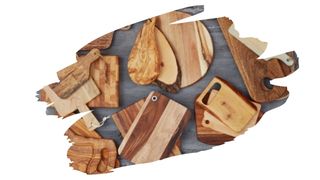Ipe wood is one of the most naturally moisture-resistant hardwoods you can get your hands on. Typically used for decking and garden furniture, this hefty lumber has grain so dense, that even water droplets struggle to sink into it.
This makes Ipe wood ideal for hardwood flooring and outdoor structures. Yet, when it comes to cutting boards, this lumber is far and away from being the best choice for a chopping block.
So, in this post, you’ll discover why wooden cutting boards are one of the most hygienic surfaces for food prep. And you’ll also find out why Ipe woods unique water-resistance (and high density) make for a less than ideal cutting board.

This post may contain affiliate links to products that we receive a commission for (at no additional cost to you). Learn more here.
Why Are Wooden Cutting Boards Food Safe?
Most types of natural solid wood are super absorbent. They readily soak up water, moisture, and even vapour, right out of the air.
This super-absorbency makes wood a ‘hygroscopic‘ substance, which is a fancy way of describing naturally super-absorbent materials.
Now, because wood can soak up liquids so well, it also soaks up raw meat juices and the like, drawing them down into its grain.
You see, bacteria will grow on any liquids or juices left on the surface. However, wood’s natural hygroscopicity doesn’t give them the opportunity to thrive.
And that makes wooden cutting boards the most food safe material to make a chopping block from. In other words, woods complete lack of water-resistance makes for a safe food prep surface.
But, Isn’t Ipe Wood Water-Resistant?
Ipe wood is one of the most rot-resistant hardwoods you will ever come across.
You see, other naturally rot-resistant woods, (such as Teak wood and Rosewood), are durable due to the fact that they have a lot of natural oils in them. These oily timbers are so packed with their own natural oil finish, that the oil prevents water from being absorbed into their wood fiber.
And if water can’t soak into wood fibers, wood rot cannot take root.
However, Ipe woods rot-resistance comes about a little differently. Ipe wood’s durability comes from it’s incredible density.
It’s so dense, that even water droplets struggle to soak into the grain of this hardwood. Only moisture and water vapour are capable of being absorbed by this tropical timber.
Now, like we mentioned earlier, one of the key reasons why wooden cutting boards are so food safe, is the fact that they absorb liquids. However, not all types of wood are equal in this regard.
And in the case of Ipe wood, those raw meat juices are more likely to stay and settle on the surface of this hardwood, than get soaked up by it.
Is This The Only Reason Why Ipe Wood Cutting Boards Aren’t That Great?
Well, another reason why you should avoid using Ipe wood for a chopping block, once again comes down to the density of this wood.
To say that this hardwood is pretty tough, is an understatement. Ipe wood is so dense that even fire struggles to burn it!
Now, all of this is great if you want to make outdoor structures and furniture. But, when it comes to cutting boards, there is such a thing as being too hard to chop.
The Janka Hardness Scale And Your Cutting Board
There are a range of different ways to measure the strength of wood. And one such way is by using the Janka Hardness Scale.
The Janka hardness scale measures how much force, (denoted by the term ‘lbf’), it takes to dent a piece of wood.
The measurement is tested by slamming a small metal ball into lumber. And the amount of force, needed to dent the wood, is given a Janka rating.
Now, when it comes to chopping blocks, the optimal Janka hardness rating is between 900 lbf and 1500 lbf.
If it takes more than 1500 pounds of force to dent a cutting board, then that wood is so tough that it’ll blunt kitchen utensils. But, if that wood will splinter under an impact of less than 900 pounds of force, then it’s simply too soft to be in the kitchen.
Here’s the rub…the Janka rating of Ipe wood is 3510 lbf. Meaning that it will take some 3510 pounds of force to crack this tremendously hardwearing lumber.
So, all in all, this wood is much too hard for a cutting board.
Related Post: Edge Grain vs Face Grain Cutting Boards (Which Is Which?)
To Wrap Up, Here Are The 3 Key Takeaways From This Post…
- 1). The advantage of using a wooden cutting board, is this materials ability to draw food liquids away from the surface.
- 2). However, Ipe wood is so dense that water droplets struggle to soak into it. And the same will go for food liquids too.
- 3). Also, Ipe wood is much too tough to be used as cutting board material. And it will almost certainly blunt your kitchen utensils.
References:
Arango, Rachel A., et al. “Natural durability of tropical and native woods against termite damage by Reticulitermes flavipes (Kollar).” International Biodeterioration & Biodegradation 57.3 (2006): 146-150.
